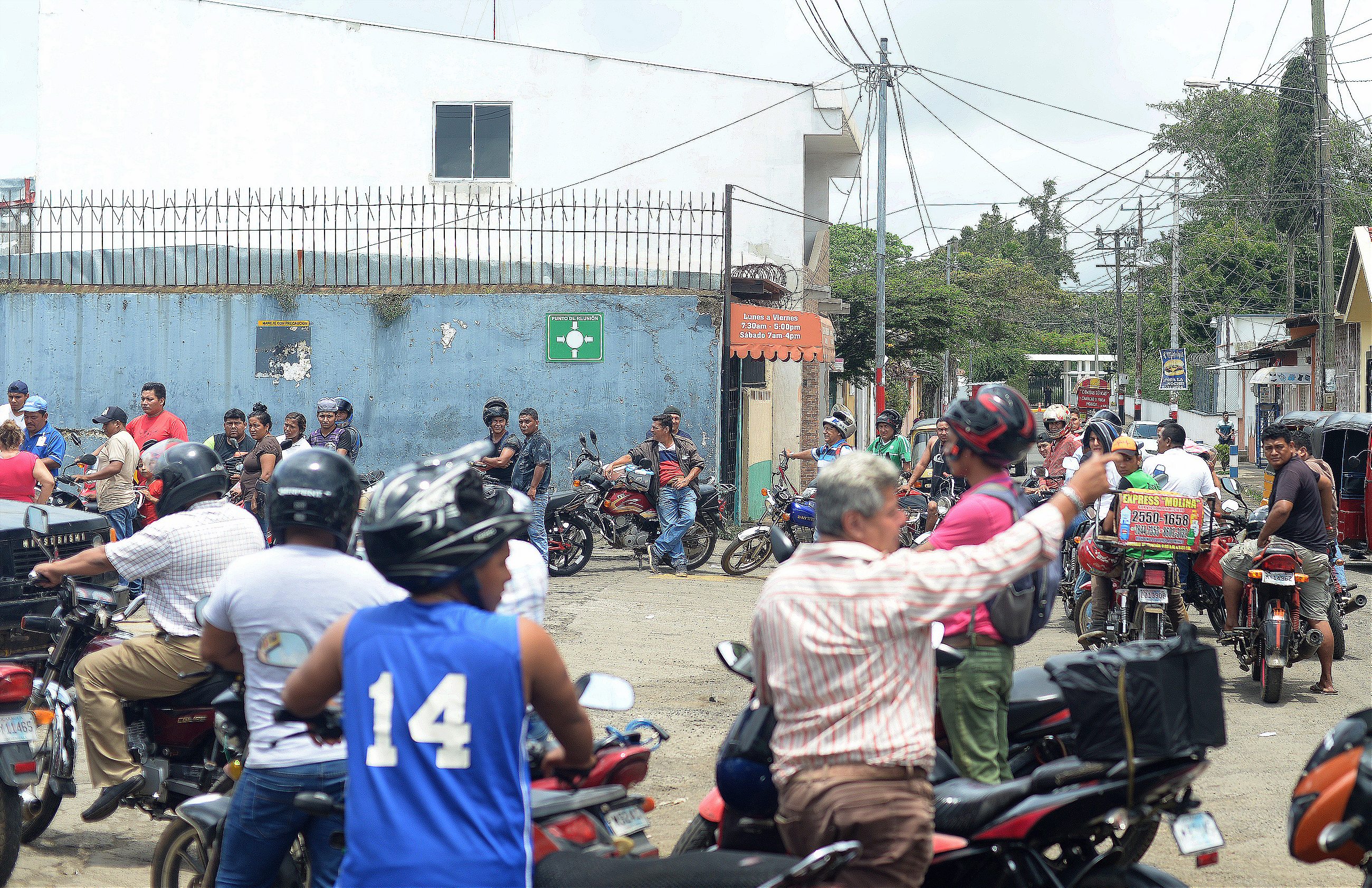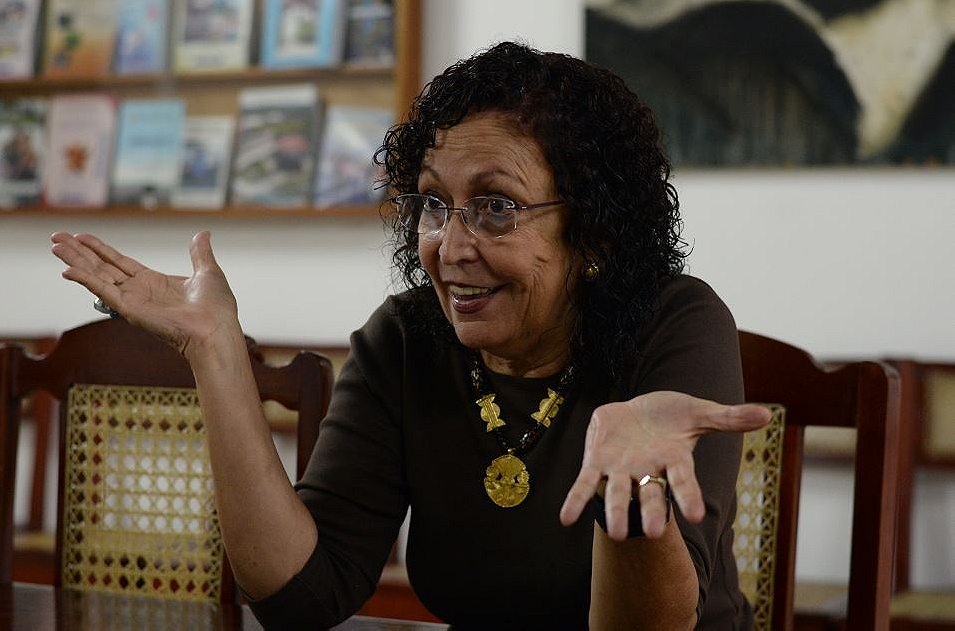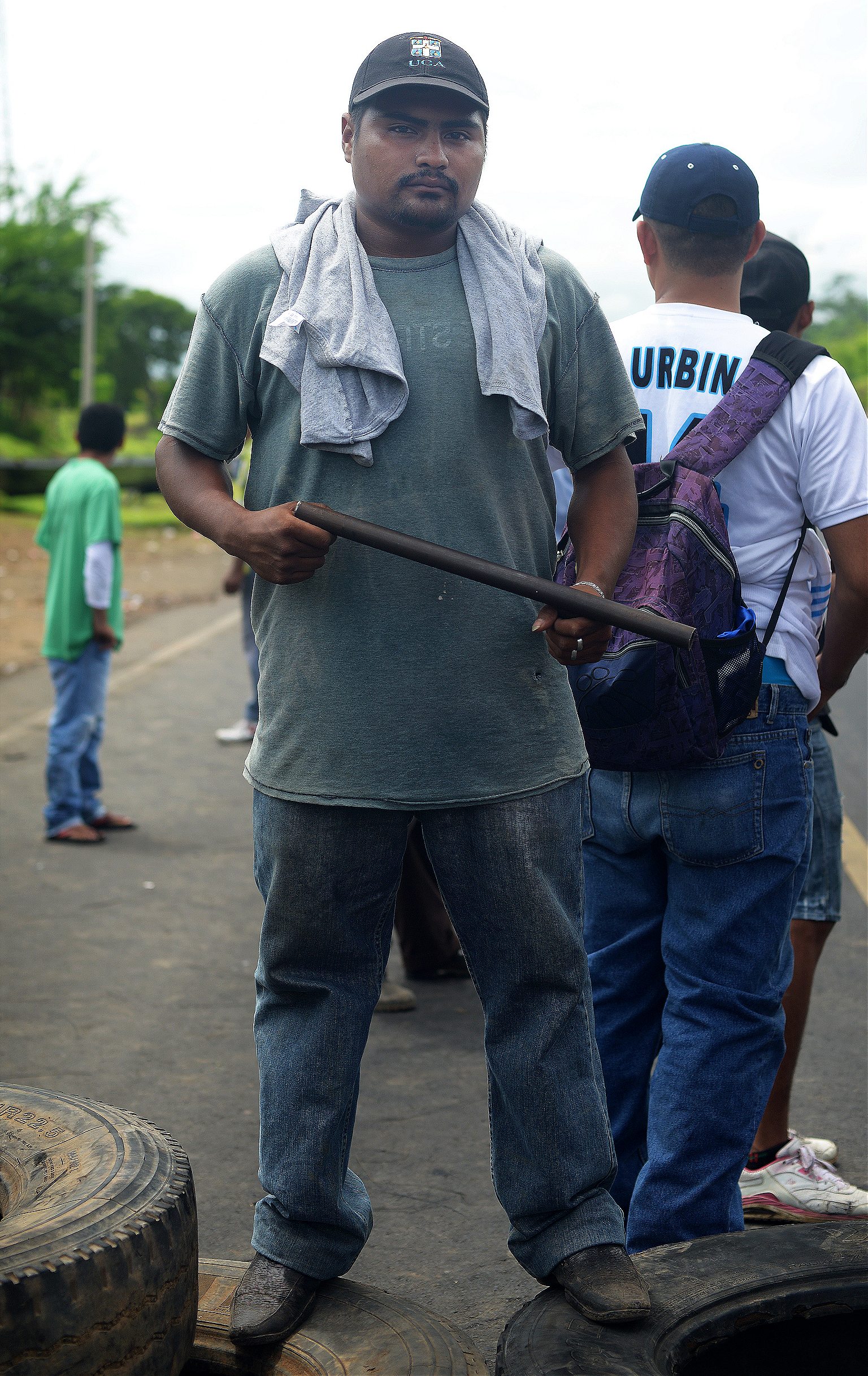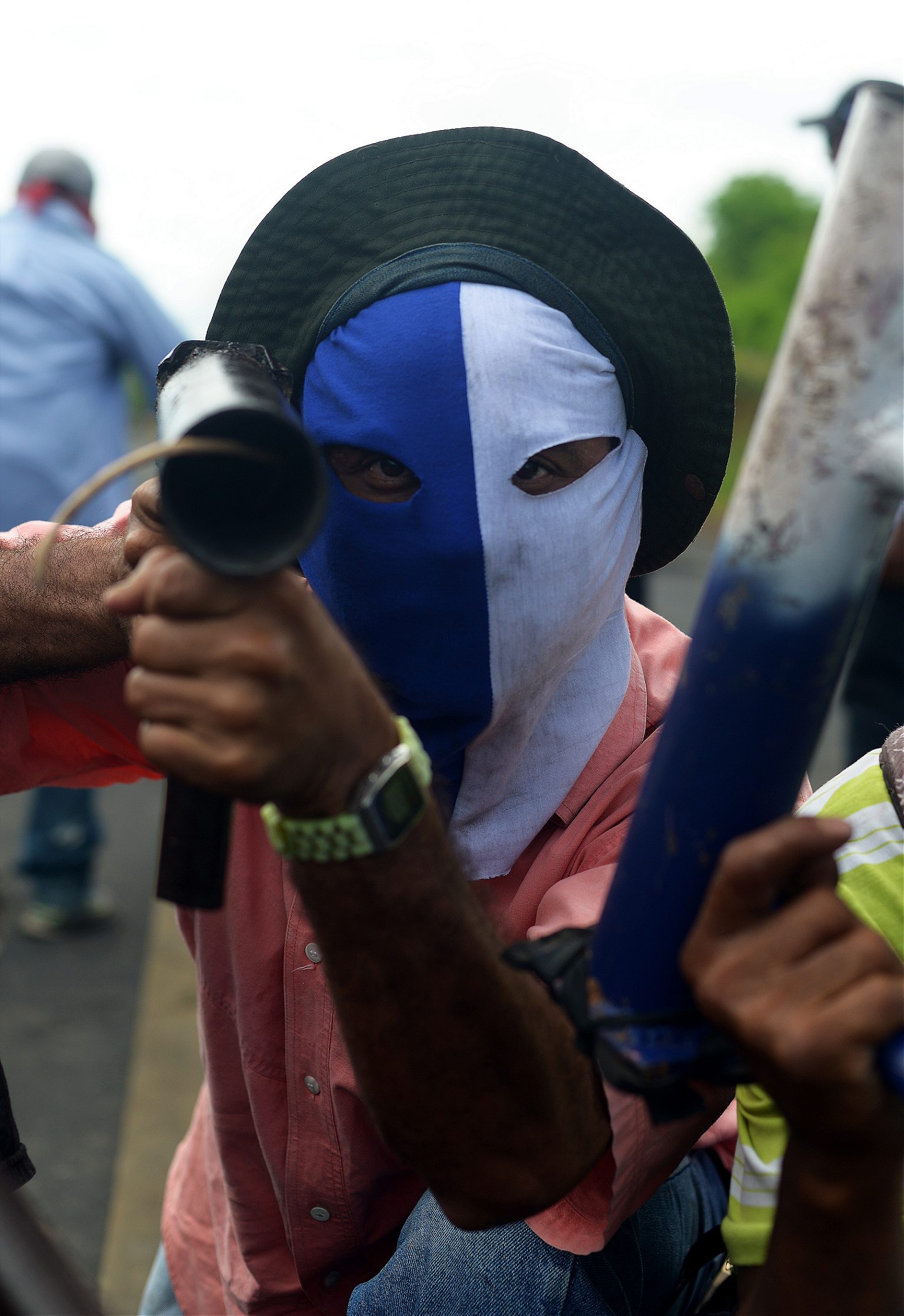Nearly three decades after the civil war ended in Nicaragua, young people have flooded streets across the nation to protest against the government led by a former revolutionary leader.
On the morning of May 30, Mother’s Day in Nicaragua, the capital city of Managua woke to fresh slogans scrawled across the walls and painted across the chests of the student leaders at the heart of the Central American nation’s latest popular uprising. “Que se rinda tu madre!” the most popular slogan read. “Give up your mother!”
Protesters tuned their radios to Radio Corporación—an independent station that has been burned to the ground on three separate occasions, purportedly by groups tied to or funded by the government of President Daniel Ortega, a former leftist revolutionary who has ruled the country since 2006. Later that day, hundreds of thousands of people would leave the festivities in their homes to flood the streets. The protestors called it “The Mother of All Marches.” Seventy-nine people were wounded. Eleven people died.
The Mother’s Day march was only the latest in a string of protests that had broken out in Nicaragua, the second-poorest nation in the hemisphere, after the Ortega regime announced a series of economic reforms that would cut pensions while increasing required contributions to the Nicaraguan Social Security Institute. Students from public universities across the country flooded the streets in solidarity with the senior citizens who would be most directly affected by the new policy.
How a $50-billion project could upend lives in Nicaragua
The protests were quickly followed by violent paramilitary groups paid by the state, called turbas, which, alongside riot police, attempted to disperse the protests by any means necessary. In the Carlos Marx neighborhood, east of Managua, the turbas set a house on fire after a family refused to allow them to place snipers inside the home. Two days later, protesters started to call for Ortega’s resignation. Since the protests began two months ago, 170 people have been killed, the majority at the hands of police and paramilitary groups.
By the first week of May, 50 former guerrillas who fought alongside Ortega during the Sandinista revolution in the 70s, had signed a statement of opposition calling for an end to his regime. Among them was 64-year-old sociologist Mónica Baltodano. For many Nicaraguans like Baltodano who lived through the 1970s, this year’s protests feel like history repeating itself. “The memory came back suddenly,” says Baltodano. “We used to complain that our young people were passive, but suddenly that memory has become a strong presence.”
Meet the Latino writer whose poems “arm the resistance”

Nicaragua is no stranger to political violence. From 1927 to 1934, Augusto César Sandino led an armed socialist uprising against the American occupation. The Sandinista uprising ended with Sandino’s assassination and the ascension of Anastasio Somoza García, who ordered the killing, to the presidential palace. Political unrest again began to resurface in the 1960s and coalesced in the Sandinista National Liberation Front (FSLN) in the early 1970s. In 1979, the Sandinista revolutionaries ousted then president and steered the government on a leftist economic platform. Ortega, a prominent leader among the Sandinista guerrilla fighters, was appointed as one of five leaders in the first post-revolution government.
On that particular spring afternoon last month, shortly after an attack on a university in Managua had left yet another young protester dead, Baltodano had stayed back from the protests to look after her granddaughters, Giulia and Kala, while their mother went out to a roadblock. As her granddaughters ran around the house, she opened a trunk, scented with sandalwood, and removed a stack of photographs—images that, taken together, constitute a timeline of her eventful life.

In the first image, it’s 1969, a short time before she and other students found the Christian Youth Movement, an antecedent to the student protests that broke out shortly after to protest the corruption of the Somoza regime, a pawn of the US government; she’s 15-years-old, sitting on a set of stairs with a group of other kids, smiling peacefully in striped pants and a beret. In the next, it’s 1974 and Baltodano wears the uniform of a Sandinista guerrilla.
Just three years later, in 1977, Baltodano would be imprisoned and tortured by the Somoza regime. Then it’s the early 1980s. The Sandinistas have triumphed and Baltodano, now an important leader in the FSLN, has gone to Cuba on a celebratory political mission to talk about the success of Nicaraguan revolution, along with her son, Panconsan, who leans his head contentedly on her shoulder, and her ten-month-old daughter, Sodana.
It’s around this time that Baltodano meets Daniel Ortega, then at the helm of the post-revolution junta and prior to his winning Nicaragua’s first free presidential election in 1984. Under Ortega’s direction, Baltodano and other former rebels organized the battle against the so-called Contras, the anti-revolutionary forces financed by the Reagan administration to dismantle the FSLN and the Sandinista government. Though Baltodano never worked closely with Ortega, she says that even in those years, his thirst for power was evident.
In the course of Ortega’s first presidency, Baltodano grew disillusioned with his leadership, as did many Nicaraguans. In 1990, Ortega lost the presidency, thanks in large part to corruption scandals in the FSLN leadership. The common people, Baltodano says, “hadn’t seen any results from his reclamations [of land], but the groups that constituted what I call the Ortegan Bourgeoisie—I refuse to call them Sandinistas—they did.” She shook her head. “What Ortega does is the iron defense of power.”
Ortega undermined the most important safeguards for a functioning democracy.
After losing the presidency, Ortega started to form alliances with right-wing groups like the Liberal Constitutional Party, the party that took power after his electoral defeat. Since 1997, Baltodano and other loyal Sandinistas have been vocal critics of the Ortega regime, which they accused of hijacking the ideals of the movement. As a result, she and other activists were ejected entirely from the FSLN and subjected to a frenzy of censure from the state-controlled media in an attempt to uproot them from the history of the country they helped to build. It was in this period that she began work on her four-volume book, Memories of the Sandinista Struggle.
For Baltodano, who founded the Movement for the Rescue of Sandinismo in 2005, Ortega ceased to be a revolutionary at least 20 years ago, when he traded the radical, transformative discourse of the revolution for alliances with big businesses. In the years since, he has, his critics say, amassed tremendous personal wealth through a network of family businesses and consolidated power over every branch of government and media.
By the time he returned to the presidency in 2007, what remained of his revolutionary ideals were already hopelessly compromised. In the course of his 2006 presidential campaign, Ortega formed a close alliance with the Catholic Church, supporting a law that criminalized abortion. Any woman seeking the procedure could receive up to two years in prison; doctors caught offering abortions could receive up to six years and lose their licenses. He created a system in which every protest was met by a state-organized counter-protest, thereby creating the impression that it wasn’t the police repressing the people, but rather the people themselves defending the second phase of the revolution.
Since returning to the presidency, Ortega undermined the most important safeguards for a functioning democracy. In 2014, Nicaragua’s Sandinista-controlled Congress eliminated term limits in revisions to the national constitution. Two years later, while running for his third consecutive term in office, Ortega used the Supreme Court to block the opposition candidate from standing. Ortega won the election with 72% of the vote. Opposition leaders and international observers agreed that the election was a farce.
“When Ortega came to the government in 2007, he started to pass reforms such that institutions stopped being—especially the police—controlled by intermediaries but rather by him directly,” Baltodano says, “That’s why armed paramilitary groups started operating in our county, the same ones that today are assassinating students.”


For this generation of protestors, the entire Sandinista movement has been tainted by the failure of the Ortega regime and the institutionalized FSLN. Fernando Sánchez, leader of a student group called the Coalición Universitaria and one of 13 student leaders listed by the Inter-American Commission on Human Rights as being in specific danger from military and paramilitary forces, says, “We’re against everyone who’s involved in this genocide. There will be different people in the future. That’s why I emphasize the people who have been sold.”
The Sandinista principals that officially brought this government to power now remain only in the form of rhetoric. At the customs checkpoints entering and exiting Nicaragua, the regime has erected billboards plastered with a photo of Ortega smiling triumphantly, marked with the phrase “Gobierno Cristiano, Socialista y Solidario”—A Government of Christianity, Socialism and Solidarity.

Today, that picture disappears behind clouds of smoke rising from burning tires, as much a symbol of a betrayed revolutionary spirit as the images of tortured students, their bodies burned, teeth and fingernails extracted, circulating among protesters. For many Nicaraguans who once supported Ortega, are the images of a nation built on lies.
The old revolutionary guard is not romantic about the unity of today’s protest movement, which emerged in the midst of a total social collapse. Students, submitted to repressive policies on the campuses of their universities, are forbidden from organizing. An economic meltdown has left many young people without jobs. Former Sandinista commander and current economic advisor to President Ortega, Bayardo Arce Castaño, has gone so far as to suggest that Nicaraguan women should look for Norwegian boyfriends if they want to escape the crisis.
Last April, in the early days of the protest movement, a young protester called Ana Patricia Quiroz was clubbed by the turbas when she took to the streets calling the current administration “assassins.” A month later, her head is still wrapped in gauze, but she continues to protest an administration full of people whom she describes as “shameless cynics.”
The upshot has been a deeply fractured protest movement led by relatively new groups, the oldest of which, the Concesión Canalera, emerged just four years ago to fight the construction of a canal that would have cut clear across the country. Despite that, the movement has grown with the astonishing speed characteristic of revolution in the era of social media.
According to Sánchez, who is a spokesman in the ongoing “National Dialogue” taking place between the Ortega government and civil society groups since last weekend, the entire movement has emerged spontaneously. With each new protest and action, organization improves. “We’ve had great achievements, fast, unexpected,” he says. “Maybe if we had had previous organization, we could have achieved more.”
“People are fighting for something as basic as liberty because there is no liberty in Nicaragua.”
Despite its disordered nature, today’s fight against authoritarianism bears marked resemblances to the revolution in which Baltodano played such an important role.
“It’s as simple as this: the people are fighting for something as basic as liberty because there is no liberty in Nicaragua,” says Baltodano. “Our fight had similar features to what you see today, like the use of roadblocks and barricades. Ortega uses the same methods of repression to the point of death.”
There are also profound differences. As her granddaughters play, Baltodano puts away the photographs and starts readying meals to send out to her daughter and the other protestors at the roadblocks. “We were part of an armed revolution,” she says. “The protestors dying today are young people with no weapons beyond their own lives.”